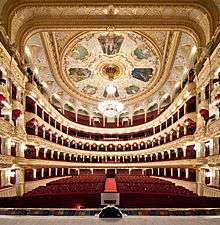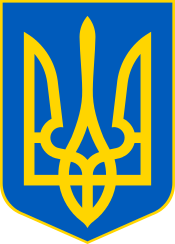Music of Ukraine
Ukrainian music covers diverse and multiple component elements of the music that is found in the Western and Eastern musical civilization. It also has a very strong indigenous Slavic and Christian uniqueness whose elements were used among many neighboring nations.[1][2]
Ukraine is also the rarely acknowledged musical heartland of the former Russian Empire, home to its first professional music academy, which opened in the mid-18th century and produced numerous early musicians and composers.[3]
Modern Ukraine is situated north of the Black Sea, previously part of the Soviet Union. Several of its ethnic groups living within Ukraine have their own unique musical traditions and some have developed specific musical traditions in association with the land in which they live.
Traditional ethnic Ukrainian music
Traditional ethnic Ukrainian music – in general
Ukraine found itself at the crossroads of Asia and Europe and this is reflected within the music in a perplexing mix of exotic melismatic singing with chordal harmony which does not always easily fit the rules of traditional Western European harmony. The most striking general characteristic of authentic ethnic Ukrainian folk music is the wide use of minor modes or keys which incorporate augmented 2nd intervals. This is an indication that the major-minor system developed in Western European music did not become as entrenched or as sophisticated in Ukraine.
Rhythmically the music rarely uses complex time-signatures, but compound meters are encountered, and the music can be extremely complex harmonically.
Harmonically three and even four part harmony had developed and was recorded in the central steppe regions of Ukraine, but was not in popular use in the mountain regions by the late 19th century.
- Ritual songs show the greatest tendency to preservation. They are frequently in recitative style, essentially monodic, based on notes in the range of a third or a fourth. An example of this style is the theme for the Shchedrivka "Shchedryk" known in the West as "Carol of the Bells".
- A large group of Ukrainian ritual melodies fall within a perfect fourth with the main central tone as the lowest note. Many of the ritual Easter melodies known as Hayivky fall into this category. The tetrachordal system is also found in wedding and harvest songs. Folk dances often have melodies based on two tetrachords fused together.
- The pentatonic scale in anhemitonic form is common in spring songs known as Vesnianky.
- The bulk of Ukrainian folk songs melodies are based on scales identical to mеdieval modes, but differ in melodic structure. The Mixolydian and Dorian modes are used more often than Ionian and Aeolian modes. This is a feature of traditional paraliturgical Koliadky.
- The augmented 2nd interval is found, as well as the raising of the fourth and seventh degree of the scale. It is often used for melodic expression. This melodic manner gives an effect that is described as adding severe tension or sadness in some Ukrainian songs. The phenomenon is not found in Russian folk songs and is thought to have been introduced or developed in the 17th century.
Traditional ethnic Ukrainian vocal music and performers
Ukrainian folk song singing style can be divided into a number of broad aesthetic categories.
1. Solo singing – primarily ritual songs including holosinnya sung at wakes.
2. Solo singing with instrumental accompaniment by professional itinerant singers known as kobzari or lirnyky. The highest form of development of this style of singing can be seen in the lyric historical folk epics known as dumy sung to the accompaniment of the bandura, kobza or lira (lirnyk). Dumy were sung primarily in the dorian mode
3. The third is an archaic type of modal "a cappella" vocal style in which a phrase sung by a soloist is answered by a choral phrase in 2- or 3- voice vertical polyphony/heterophony/harmony. The vocal inflection here is quite mediaeval in character, and some peculiarities of distinctly Ukrainian flavor are noticeable, such as parallel fifths and octaves, and several types of plagal cadences. This type of song, once dominant, after 1650 has ceded its hegemony to the newer tonal types, but can still be found in isolated villages. This style is evident in the "Kolyadka" and "Shchedryk".
4. *The other vocal styles are marked by the influences exerted by European music, by paraliturgical music of Danylo Tuptalo and his circle in the early 18th century, and later by classical music and urban culture.
Ukrainian vocal musics exhibit a wide variety of forms – monodic, heterophonic, homophonic, harmonic and polyphonic.
One of the most active proponents of these styles of Ukrainian vocal music is Nina Matviyenko. In recent time groups have been established dedicated to preservation to Ukrainian traditional polyphony, notably "Bozhychi", "Hurtopravci", "Volodar", "Korali" and "Drevo".
Traditional ethnic Ukrainian instrumental folk music and performers
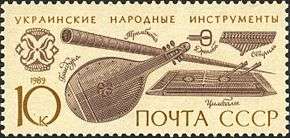
Common traditional instruments include: the kobza (lute), bandura, torban (bass lute), violin, basolya (3-string cello), the relya or lira (hurdy-gurdy) and the tsymbaly; the sopilka (duct flute), floyara (open, end-blown flute), trembita (alpenhorn), fife, volynka (bagpipes); and the buben (frame drum), tulumbas (kettledrum), resheto (tambourine) and drymba/varhan (Jaw harp). Traditional instrumental ensembles are often known as troïstï muzyki (literally ‘three musicians’ that typically make up the ensemble, e.g. violin, sopilka and buben). When performing dance melodies instrumental performance usually includes improvisation.
The traditional dances of Ukraine include: the Kozak, Kozachok, Tropak, Hopak, Hrechanyky, Kolomyjka and Hutsulka, Metelytsia, Shumka, Arkan, Kateryna (Kadryl) and Chabarashka. Dances originating outside the Ukrainian ethnic region but which are also popular include: the Polka, Mazurka, Krakowiak, Csárdás, Waltz, Kamarinskaya and Barynya. Ukrainian instrumental and dance music has also influenced Jewish (Hava Nagila-Let's rejoyce) and Gypsy music and much of it was included in the repertoire of itinerant klezmorim.
Early in the 20th century, Pavlo Humeniuk of Philadelphia became famous in North America for his fiddle music.
Traditional vocal-instrumental folk music and performers
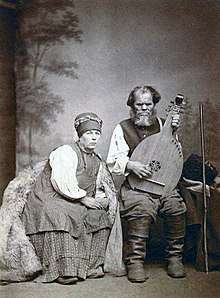
Although most instrumental dance music in Ukraine can be sung to, there exist in Ukraine a group of professional folk musicians who sing to their own accompaniment. These itinerant musicians were generically called kobzari (kobzar – singular), and accompanied their singing with the kobza, bandura, or lira. Although their origins stretch back to antiquity, their repertoire and customs directly date back to the 17th century in which they depict the period of the conflicts between the Kozaks and various foreign oppressors. There were many cases of those folk singers being blind which became a stereotype in the cultural memory.
- Kobzari
The kobzari organized themselves into regional professional guild-like structures, known as a "Kobzar Guild".
During Soviet era almost all of the traditional kobzari were killed, the bulk perishing during Stalin's "purges" during the 1930s. Even the instrument, kobza and bandura, were prohibited and confiscated. A practice of the Ukrainian ethnocide that continued after the fall of the Russian Empire.
Under the inspiration of noted traditional bandurist Heorhiy Tkachenko a Kobzar Guild was re-established in 1991 in Kiev by Mykola Budnyk in order to revive and foster the ancient kobzar traditions. The Guild unites many singer-musicians in Ukraine and the Ukrainian diaspora. Many of its members are not formally Conservatory trained.
- The most notorious songs and music
- Cossacks march
Ritual instrumental music
Although not precisely definable as music, there are signals played on the trembita (a type of alpenhorn, to signify death, birth, a marriage or another significant event) by the Hutsuls in the Carpathian mountains.
Pseudo-folkloric music
With the establishment of the Soviet regime in Ukraine a policy based on state atheism was instituted which gradually grew to an intolerance to organized religion. Religious music was not supported by the regime and in time was purged from performance. Many aspects of classical music were also branded as being bourgeois and decadent.
A movement was started in the 20s for "Proletarian songs" – music of the working people. In time it was noticed that this music only catered for the working classes in the cities and did not take into account the large percentage of Ukrainian peasants living in village setting. As a consequence, songs of the village were also defined as being also from the working class. Resulting from this reclassification the Soviet government began to give significant support to this form of music. Hence, various "fakeloric" ensembles came into existence. After World War II huge resources continued to be given to support this style of music in order to displace the onslaught of mass culture from the West.
Numerous folk choirs were established such as the Veriovka folk choir directed by Hryhoriy Veriovka. A stylized dance troupe was established by Pavlo Virsky based on a synthesis of ethnographic dance and ballet. Particularly popular were the numerous Bandurist Capellas. These particular pseudo-folk forms blending ethnographic materials in an art setting have also become popular in the Ukrainian diaspora in North America.
Traditional music and the Bandura
In North America pseudo-folk or "reconstructive" bandurists such as Zinoviy Shtokalko, Hryhoriy Kytasty, Julian Kytasty, Victor Mishalow, et al. have played a significant role in defining Ukrainian ethnicity in the New World, while fusing traditional musical material with new possibilities offered by contemporary instruments.
Traditional music of non-Ukrainian ethnic minorities in Ukraine
Of the traditional musics of non-Ukrainian ethnic minorities living in Ukraine possibly the richest and most developed is that of Jewish Klezmer music which can trace most of its origins to the Jewish Pale of Settlement and to South-western Ukraine. It is estimated that one third of the total Jewish population of Europe lived on Ukrainian ethnic territory at the turn of the 19th century
Russian music has also had a strong base for development in Ukraine. Many of the early performers on Russian folk instruments came from Ukraine and these performers often included Ukrainian melodies in their repertoire. The 4 string Russian domra continues to be used and taught in Ukraine despite the fact that it has been replaced by the 3 string domra in Russia proper.
Ukrainized versions and borrowed music
- Polonaise
- The Hills of Manchuria (Ukrainian: На сопках Манчжурiї – Ми пам'ятаєм)
Popular Ukrainian folk songs
- "Ikhav Kozak za Dunaj"
- "Pidmanula Pidvela"
- "Nich Yaka Misyachna"
- "Shchedryk" – originally an ancient folk chant arranged by Mykola Leontovych
- Zaporozhets za Dunayem – comic opera based on popular folk song
- "Oi ne khody, Hrytsiu" – by popular folk artist Marusia Churai
- "Rospryagayte Chloptzi Koney" – originally Ukrainian folk song
Art (Classical) music
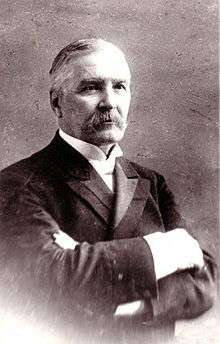
Ukrainian art (classical) music can be divided up into ethnic sub-categories:
- 1) Composers and performers of Ukrainian ethnicity living in Ukraine.
- 2) Composers and performers of non-Ukrainian ethnicity who were born or at some time were citizens or were active in Ukraine.
- 3) Ethnic Ukrainian composers and performers living outside of Ukraine within the Ukrainian diaspora.
The music of the above groups differs considerably, as did the audiences for whom they cater.
The first category is closely tied with the Ukrainian national school of music spearheaded by Mykola Lysenko. It includes such composers as Kyrylo Stetsenko, Mykola Leontovych, Levko Revutsky, and Sydir Vorobkevych. Most of their music contains Ukrainian folk figures and are composed to Ukrainian texts.
The second category is of particular importance and international visibility, because of the large percentage of ethnic minorities in urban Ukraine. This category includes such composers as Franz Xavier Mozart, Isaak Dunayevsky, Rheinhold Gliere, Yuliy Meitus and Sergei Prokofiev, performers Volodymyr Horovyts, David Oistrakh, Sviatoslav Richter and Isaac Stern. The music of these composers rarely contains Ukrainian folk motives and more often is written to the texts of Russian or Polish poets.
In the third category we have a number of prominent individuals who are often not part of the mainstream Ukrainian culture but who have made a significant impact on music in Ukraine, while living outside of its borders. These include historic individuals such as: Bortniansky, Berezovsky, Vedel, Tuptalo and Titov. It also contains Soviet composers such as Mykola Roslavets and Isaak Dunayevsky who were born in Ukraine but who moved to other cultural centres within the Soviet Union. In North America we have Mykola Fomenko, Yuriy Oliynyk, Zinoviy Lawryshyn and Wasyl Sydorenko.
Baroque and classical music
During the Baroque period, music was an important discipline for those that had received a higher education in Ukraine. It had a place of considerable importance in the curriculum of the Kyiv-Mohyla Academy. Much of the nobility was well versed in music with many Ukrainian Cossack leaders such as (Mazepa, Paliy, Holovatyj, Sirko) being accomplished players of the kobza, bandura or torban.
In the course of the 18th century in the Russian Empire court musicians were typically trained at the music academy in Hlukhiv, and largely came from Ukraine. Notable performers of the era include Tymofiy Bilohradsky who later studied lute under Sylvius Leopold Weiss in Dresden, his daughter Yelyzaveta who was a famous operatic soprano, and Oleksiy Rozumovsky, a court bandurist and the morganatic husband of Empress Elizabeth.
The first professional music academy was set up in Hlukhiv, Ukraine in 1738 and students were taught to sing, play violin and bandura from manuscripts. As a result, many of the earliest composers and performers within the Russian empire were ethnically Ukrainian, having been born or educated in Hlukhiv, or had been closely associated with this music school. See: Dmytro Bortniansky, Maksym Berezovsky, Artemiy Vedel.
Romantic and nationalist schools
Mykola Lysenko, Mykola Leontovych, Kyrylo Stetsenko, Yakiv Stepovy
Soviet Romantic school
Rheinhold Gliere, Borys Lyatoshynsky, Lev Revutsky, Mykola Vilinsky, Anatoliy Kos-Anatol'sky, Andriy Shtoharenko, Mykola Dremliuha, Samuel Maykapar, Oleksandr Bilash, Ivan Karabyts.
- See also:Music of the Soviet Union
Soviet modernist school
Avant garde music
Ukraine and its diaspora have also produced a great number of fine avant-garde composers with widely varying degrees of affinity with the folk idioms, such as
- Virko Baley,
- Valentin Silvestrov,
- Leonid Hrabovsky.
There are also musicians that are difficult to categorize, such as
- Mariana Sadovska – avantgarde and folk singer and composer
- Roman Turovsky – historicist lutenist-composer
Early music revival
There are also musicians in Ukraine (Kostyantyn Chechenya, Vadym Borysenko) and in diaspora (Volodymyr Smishkevych, Julian Kytasty, Roman Turovsky) who have been preserving Ukrainian music of the Medieval, Renaissance and Baroque Eras.
Pop music
Ukrainian musicians and composers
- Mykola Lysenko. 1842–1912. Composer, pianist, and patron. He is considered the father of Ukrainian classical music.
- Semen Hulak Artemovsky. 1813–1873. Composer of opera "Zaporozhetz za Dunayem" (Kozaks beyond the Danube).
- Mykola Leontovych. 1877–1921. Composer. Best known worldwide for his arrangement of Shchedryk, which became known in North America as "Carol of the Bells."
- Dmytro Bortniansky . 1751–1825. Ukrainian liturgical composer. Born Hlukhiv, Ukraine.
- Reinhold Gliere. 1875–1956. Composer. Born in Kiev.
- Mykola Vilinsky. 1888–1956. Ukrainian classical composer and teaching professor.
- Oleksandr Bilash. Ukrainian classical and popular song composer. His best known song is Dva Kolery (Two Colors).
- Myroslav Skoryk. Ukrainian classical composer.
- Volodymyr Ivasiuk. 1949–1979. Ukrainian popular song composer. His best known song is Chervona Ruta.
- Valentin Silvestrov modern ukrainian "minimalistic music" composer. His best known work is "Quiet songs" for bariton voice.
- Julia Gomelskaya 1964– Ukrainian contemporary composer of symphony, chamber, choir and vocal music.
- Venya Drkin. 1970–1999. Ukrainian composer, bard, poet, artist and writer of fairy tales.
- Svitlana Azarova 1976– Ukrainian composer of contemporary classical music
- Aleksandr Shymko
- Roman Miroshnichenko 1977 – jazz-fusion guitarist, composer, producer. Independent Music Awards winner.
- Sons of Day – a Ukrainian alternative rock band that lives in the United States and sings almost exclusively in English
- Make Me Famous – a Ukrainian metalcore band that is signed to Sumerian Records. All lyrics by the band are solely written in English.
Works by non-Ukrainian composers using Ukrainian folk material
- Karol Szymanowski, Polish composer, born in Ukraine.
- Stepan Rak, b. 1945, Prolific Czech composer and guitarist. "... identifies the village Chust in Ukraine as the place where the newborn infant, who was later christened as Stepan Rak, was found by Soviet soldiers in a bomb-wrecked house."
- Béla Bartók – Rhapsody no 2. for violin
- Ludwig van Beethoven – Razumovsky Quartets, Opus 59 No. 1-3, Air de la Petite Russe,
- Luigi Boccherini –
- Johannes Brahms –
- Dargomyzhsky – Kozachok
- Antonín Dvořák – Dumky trios
- Alexander Glazunov – Hopak
- Reinhold Gliere – Ballet "Taras Bulba" based on Gogol's Novell
- Mikhail Glinka –
- Mikhail Goldstein
- Joseph Haydn – String quartet no. 20. opus 9 no. 2
- Johann Nepomuk Hummel – Trio op. 78 in A major
- Dmitri Kabalevsky – Violin concerto
- Hans Kockelmans
- Vanessa Lann – Two Ukrainian Folk Sketches for B-flat clarinet and piano
- Franz Liszt- Mazeppa Symphonic poem No. 6, Ballade d'Ukraine
- Miaskovsky –
- Stanisław Moniuszko _
- Franz Xaver Mozart –
- Modest Mussorgsky – Opera "The fair of Sorotcincy"
- Walter Piston – Ukrainian Suite for orchestra
- Quincy Porter – Ukrainian suite for strings
- Sergei Prokofieff – Opera "Semjon Kotko"
- Sergei Rachmaninoff – Piano Concerto no 3.
- Nikolai Rimsky-Korsakov –
- Andrei Sychra
- Piotr Tchaikovsky – His Symphony No. 2 in C minor is nicknamed "Little Russian" (Russian: Малороссийская, Malorossiyskaya) because of its use of Ukrainian folk themes. He wrote an opera "Mazepa" based on Pushkin's poem. Piano concerto No. 1 (Finale based on ukrainian folk song "Go, go, Iwan").
- Carl Maria von Weber – Variation for Piano op. 40
Ukrainian performers and composers
- Virko Baley. Composer. Conductor of Las Vegas Symphony.
- Dmitri Tiomkin. 1899–1979. Born Poltava, Ukraine. American film composer (Academy Award for score of movie High Noon, also best song from that movie "Do Not Forsake Me, Oh My Darling"). A U.S.A. postage stamp was issued in his honor.
- Gary Kulesha, Ukrainian-Canadian composer.
- Victor Mishalow
- Alexis Kochan
- Julian Kytasty
- Roman Turovsky
- Darka and Slavko
- Oleksandr Semchuk
See also
Literature
- Alexis Kochan and Julian Kytasty. "The Bandura Played On". 2000. In Broughton, Simon and Ellingham, Mark with McConnachie, James and Duane, Orla (Ed.), World Music, Vol. 1: Africa, Europe and the Middle East, pp 308–312. Rough Guides Ltd, Penguin Books. ISBN 1-85828-636-0
- Victor Mizynec, Folk Instruments of Ukraine. 1987. Bayda Books, Doncaster, Australia. ISBN 0-908480-19-9
References
- Ukrainian Music Elements, Canadian Institute of Ukrainian Studies, 2001.
- The artistic tradition of Ukrainian wandering bards, the kobzars (kobza players), bandurysts (bandura players), and lirnyks (lira players) is one of the most distinctive elements of Ukraine's cultural heritage., Canadian Institute of Ukrainian Studies, 2001.
- Ukraine is the rarely acknowledged musical heartland of the former Russian Empire Archived 2011-05-15 at the Wayback Machine, National Geographic Society, 2012.
Bibliography
§1: Folk music §1a: Important Folk song collections
- Dey, O.I. and S.Y. Hrytsa, eds.: Spivanky-khroniky (Kiev, 1972)
- Goshovsky, V.L. : Ukrainskiye pesni Zakarpat'ya [Ukrainian songs of Transcarpathia] (Moscow, 1968)
- Hnatyuk, V.M., Y.Rozdol's'ky and F. Kolessa: Hayivky (Lemberg, 1909) [with Ger. summary]
- Khredorovnich, A., A. Konoshchenko and B. Arsen: Ukraïns'ki pis'ni z notamï [Ukrainian songs with music] (Odessa, 1900–04)
- Kolberg, O. : Pokucie: obraz etnograficzny [Ethnographic sketch of Pokucie] (Kraków, 1882–8/R)
- Kolberg, O. : Chełmskie: obraz etnograficzny [Ethnographic sketch of Chełmskie] (Kraków, 1890–91/R)
- Kolberg, O. : Przemyskie: zarys etnograficzny (Kraków, 1891/R)
- Kolberg, O. : Wołyń obrzędy, melodye, pieş'ni [Rituals, melodies, songs], ed. J. Tretyak (Kraków, 1907/R)
- Kolessa, F.M. : Melodiï ukraïns'kikh narodnykh dum [Tunes of Ukrainian historical epics] (Lemberg, 1910–13, 2/1969)
- Kostyuk, Yu. : Ukrayins'ki narodni pisni Pryashivs'koho krayu (Bratislava, 1958)
- Kvitka, K. : Ukraïns'ki narodni melodiï [Ukrainian folksongs] (Kiev, 1922)
- Kvitka, K. : Narodni melodiï z holosu Lesi Ukraïnky [Folksongs from the voice of Lesya Ukrayinka] (Kiev, 1917–18, enlarged 2/1973 by S.Y. Hrytza and O.J. Dey, 3/1977)
- Lipinski, K. : Muzyka do piesni polskich i russkikh ludu galitsyskiego [Music to the songs of the Polish and Russian people of Galicia] (Lemberg, 1833)
- Lysenko, M.V. : Ukraïns'ki narodni pisni [Ukrainian folksongs] (Kiev, 1868–1906); rev. in Zibrannya tvoriv, xv–xviii (1953–8)
- Pravdyuk, O.A. and M.M. Shubravs'ka: Vesillya (Kiev, 1970)
- Revuts'ky D. : Zoloti klyuchi (Kiev, 1926–9, 2/1964)
- Rubets, A. : 216 narodnïkh ukrainskikh napevov [216 Ukrainian folk melodies] (Moscow, 1872, 2/1882)
- Shubravs'ka, M.M. and H.J. Ivanyc'ky: Vesilni pisni: u dvokh knyhakh (Kiev, 1982)
- Tansyura, H. : Pisni Yavdokhy Zuyikhy, ed. V.A. Yusvenko and M.T. Yatzenko (Kiev, 1965)
- Tsimbora, Yu. : Ukrayins'ki narodni pisni Skhiddnoyi Slovachchyny (Prešov, 1963)
Ukraine, §1b: Ethnomusicological studies
- Kirdan, B.P. ed.: Ukrainskiye narodnïye dumï (Moscow, 1962, enlarged 2/1972 by V.M. Gatsak)
- Goshovsky, V.L. : U istokov narodnoy muzïki slavyan [The sources of Slavonic folk music] (Moscow, 1971)
- Harasymchuk, R. : Tantse hutsulskiye (L'viv, 1939)
- Hordiychuk, M.M. ed.: Ukraïns'ke narodne bahatoholossya: zbirkny pisen' (Kiev, 1963)
- Hrinchenko, M.O. : Vybrane, ed. M.M. Hordiychuk (Kiev, 1959)
- Hrytsa, S. ed.: Muzychniy fol'klor z Polissya v sapysach F. Kolessy ta K. Moshyns'koho (Kiev,1995)
- Hrytsa, S.Y. : Melos ukrayins'koï narodnoï ėpiky (Kiev, 1979, enlarged 2/1990 as Ukrainskaya pesennaya epika)
- Ivanyc'kyj, A.I. : Ukrayins'ka narodna muzychna tvorchist' (Kiev, 1990)
- Kolessa, F.M. : Rytmika ukrayins'kykh narodnykh pisen' [The rhythm of Ukrainian folksongs] (Lemberg, 1906–7)
- Kolessa, F.M. : ‘Über den melodischen und rhythmischen Aufbau der ukrainischen (kleinrussischen) rezitierenden Gesänge, der sogenannten “Kosakenlieder”’, IMSCR: III Vienna 1909, 276
- Kolessa, F.M. : ‘Das ukrainische Volkslied, sein melodischer und rhythmischer Aufbau’, Österreichische Monatsschrift für den Orient, xlii (1916), 218
- Kolessa, F.M. : Pro genezu ukrayins'kykh narodnykh dum [On the origin of the Ukrainian folk epics] (Lwów, 1921)
- Kolessa, F.M. : Narodni pisni z Halyts'koï Lemkivshchyny [Folksongs from west Galicia, Lemky country] (Lwów, 1929)
- Kolessa, F.M. : ‘Narodni pisni z Pidkarpats'koï Rusi’ [Folksongs from Subcarpathian Ruthenia], Naukoviy zbirnyk tovarystva ‘Prosvita’ v Uzhgorodi, xiii–xiv (1938), 49–149
- Kolessa, F.M. : Fol'klorystychni pratsi [Works on folklore], ed. V.A. Yuzvenko (Kiev, 1970)
- Kolessa, F.M. : Muzykoznavchi pratsi [Musicological works], ed. S.Y. Hrytsa (Kiev, 1970)
- Kvitka, K.L. : Izbrannïye trudï [Selected works], ed. V.L. Goshkovsky (Moscow, 1971–3)
- Mierczyński,S. ed.: Muzyka Huculszczyzny [Music of the Hucuły region] (Kraków, 1965)
- Vasylenko, Z.I. ed.: Zakarpatski narodni pisni (Kiev, 1962)
- Yashchenko, L.I. : Ukraïns'ke narodne bahatoholossya (Kiev, 1962)
§1c: Organology
- K. Vertkov, G. Blagodatov and E. Yazovitskaya, eds.: Atlas muzïkal'nïkh instrumentov narodov SSSR [Atlas of the musical instruments of the peoples of the USSR] (Moscow, 1963, 2/1975 with 4 discs)
- Humenyuk, A.I. : Ukraïns'ki narodni muzychni instrumenty [Ukrainian folk musical instruments] (Kiev,1967)
§2: Art music – general references
- Yu. V. Keldïsh, ed.: Muzïkal'naya ėntsiklopediya (Moscow, 1973–82)
- V. Kudryts'ky, ed.: Mysteztvo Ukrainy: Ėntsyklopedia (Kiev, 1995–)
- V. Kudryts'kyi, ed.: Mysteztvo Ukrainy: Biohrafichniy dovidnyk (Kiev, 1997)
§2a: Art music – general
- Arkhimovych, L. and others: Narysy z istorïï ukraïns'koï muzyky [Outline of the history of Ukrainian music] (Kiev, 1964)
- Arkhimovych, L. ed.: Istoriya Ukraïns'koï Radyans'koï muzyky [The history of Soviet Ukrainian music] (Kiev,1990)
- Barvyns'ky, V. : ‘Ohliad istorïï ukraïns'koï muzyky’ [A survey of the history of Ukrainian music], Instoriya ukraïns'koï kultury, ed. I. Kryp'yakevych (Lwów, 1937)
- Dovzhenko, V. : Narysy z istorïi ukrains'koï radyanskoï muzyky [Study of the history of Soviet Ukrainian music] (Kiev, 1957–67)
- Hordiychuk, M. and others, eds.: Istoriya ukraïns'koï muzyky (Kiev 1989–)
- Hordiychuk, M. : Ukraïns'ka radyans'ka symfonichna muzyka [The symphonic music of the Soviet Ukraine] (Kiev, 1969)
- Hrinchenko, M.: Istoriya ukrainskoï muzyky (Kiev, 1922; Eng. trans., 1961)
- Kozyts'ky, P. : Spiv i muzyka v Kivsky akademïïza 300 rokivïï isnuvannya (1917) [Singing and music at the Kiev Academy during its 300 years of existence] (Kiev, 1971)
- Rudnytsky, A. : Ukraïns'ka muzyka: istorychno-krytychny ohlyad [Ukrainian music: a historical and critical outline] (Munich, 1963)
- Samokhvalov, V. : Chertïy muzïkal'nogo mïshleniya B. Lyatoshinskogo (Kiev, 1970, 2/1977, as Chertï simfonizma B. Lyatoshinskogo)
- Shreier-Tkatchenko, O. : Istoriya ukrayns'koy dozhovtnevoy muzïkï [The history of Ukrainian music before the October Revolution] (Kiev, 1969)
- Shreier-Tkatchenko, O. ed.: Istoryia ukraïns'koï muzyky (Kiev, 1980)
§2: Art music – specific
- O. Zin'kevïch: Dinamika obnovleniya: ukrainskaya simfoniya na sovremennoy ėtapye v svete dialektiki traditsii i novatorstva (1970–1980-kh godov) [The dynamics of revival: Ukrainian contemporary symphonic music as part of the dialectics of tradition and innovation, in the period 1970–80] (Kiev, 1986)
- Y. Stanishevsky: Operny teatr Radyans'koï Ukrainy [Opera theatre in Soviet Ukraine] (Kiev,1988)
- Y. Rozdol's'ky and S. Lyudkevich: Halyts'ko-rus'ki narodni mel'odiyi (Lemberg, 1906–8)
- P.P. Sokal'sky: Russkaya narodnaya muzïka, Velikorusskaya i Malorusskaya, v yey stroyeni melodicheskom i ritmicheskom [Russian folk music, Great Russian and Little Russian in its melodic and rhythmic construction] (Khar'kiv, 1888; Ukrainian trans., 2/1959)
§3: Religious music
- Herasymova-Persyds'ka N. : Partesniy kontsert v istorii muzïkal'noy kul'turï [The Partesny concerto in the history of musical culture] (Moscow, 1983)
- Herasymova-Persyds'ka, N. : Khorovyi kontsert na Ukraini v XVII–XVIII st. [The choral concerto in Ukraine during the 17th and 18th centuries] (Kiev, 1978)
- Kudryk, B. : Ohlyad istorïi ukrains'koï tserkovnoï muzyky [Outline of the history of Ukrainian church music] (Lwów, 1937)
§4: Books and articles
- Ukrains'ke Muzykoznavstvo [Ukrainian musicology] (Kiev, 1963–98)
- D. Saunders: The Ukrainian Impact on Russian Culture, 1750–1850 (Downsview, ON, 1985)
- M. Stepanenko, ed.: Ukraïns'kiy Muzuchniy Archkiv, i: Tsentrmuzinform (Kiev, 1995)
- Musicae Aes Et Scientia. Naukovyi Visnyk, Vypusk 6 [Scholarly Herald, Volume 6], *Natzional'na Akademiya Ukrainy [National Music Academy of Ukraine], Kiev, 1999
§5: Sources in English
External links
- Polyphony Project - Ukraine’s largest online archive of musical folklore
- Audio clips: Traditional music of Ukraine. Musée d'ethnographie de Genève. Accessed November 25, 2010. (in French)
- Public Domain scores of Ukrainian music on-line:
- Ukrainian baroque songs. Audio files
- Ukrainian art songs. Audio files
- Ukrainian tango songs. Audio files
